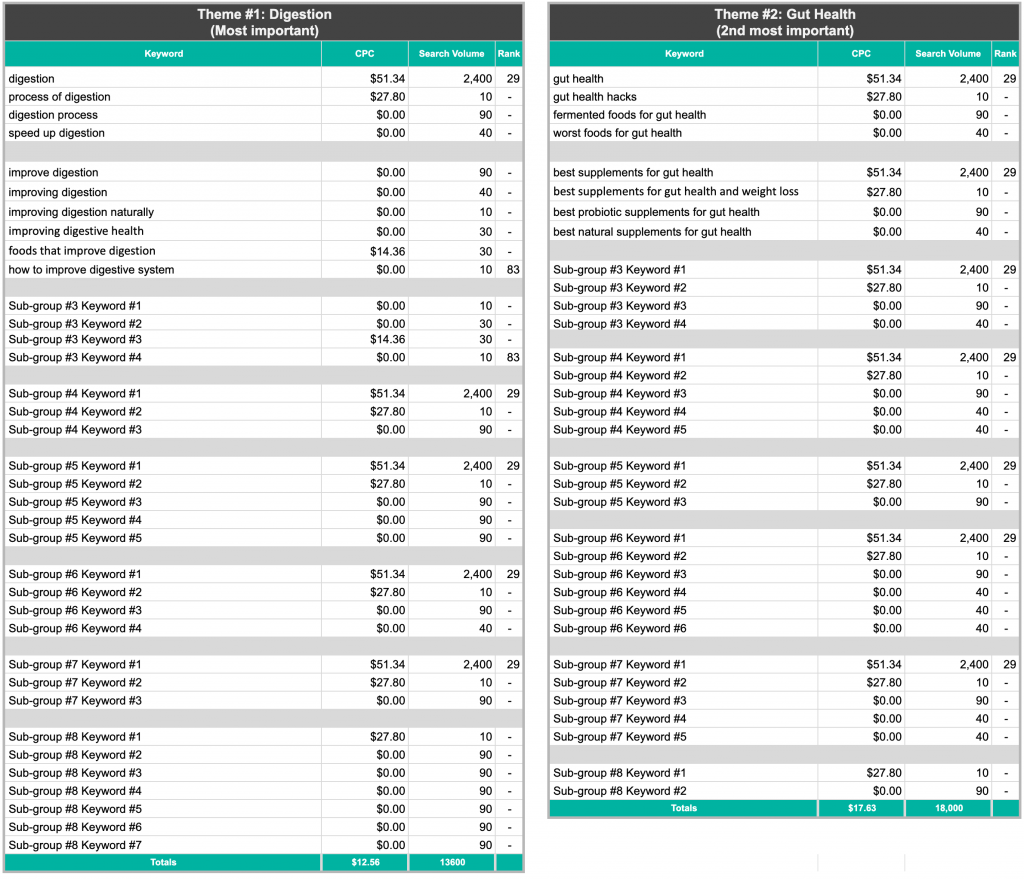Why a Keyword Theme Strategy is the fastest and most systematic way to approach content development for your team.
Deep in the South Pacific, a unique creature swims the ocean’s depths. The chambered nautilus, or Nautilus pompilius, has been around for over 500 million years.

The Nautilus
The nautilus is a cephalopod, related to squids and octopuses. But unlike its cousins, it has a unique and beautiful shell it uses to control its buoyancy in the depths of the ocean. As the animal grows, the nautilus forms new, larger chambers in its shell, allowing it to move into the new chamber and seal off the previous one.
This process, known as “teleoconch septation,” allows the nautilus to maintain a constant ratio of shell to body size. Helping it maintain neutral buoyancy as it moves through the deep ocean. Anyone who’s gone scuba diving understands the importance of neutral buoyancy. It allows you to swim without sinking down to the sea floor, or bobbing up to the surface like a cork.
Like the nautilus, a business must constantly adapt and navigate in order to survive in its industry. By developing a Keyword Theme Strategy, a business can align its SEO and content strategies, just as the nautilus uses its shell to adapt and control its buoyancy. The nautilus serves as an inspiration for adaptability and survival, much like a well-executed strategy can be for a business.
Most Businesses Struggle to Create Content in a Systematic Way
Building a clear content strategy that aligns to a SEO strategy is quite difficult for many businesses. It’s a constant source of confusion as to what content to write first, which keywords to prioritize, or not. This confusion seems to be ubiquitous for many businesses as they are not able to align the content strategy with their SEO prioritization.
To solve this we need to take a page out of the nautilus’ playbook, and approach content development systematically.
Covering one content section of the theme strategy, then the next, and the next. But we approach this with a thought of creating both the difficult, more competitive content, and the easier less competitive content that will attract traffic and ranking quickly.
One of the most effective tools I’ve used throughout my career in marketing is a Keyword Theme Strategy. This system is something I’ve developed to help align SEO and content strategies.
Who needs a system that attracts targeted traffic, helps rankings, and gets content production under control?

Look at each green circle as a new keyword theme organized around a focused topic. You can see how your content strategy grows naturally if you stick to the system.
It’s an essential tool to organize the process of developing content strategy. It naturally teaches and trains my team the process and system I want them to use (which is very simple, but also multi-faceted and comprehensive). And once the team understands the process everything is really easy to scale using the system (we can onboard 3rd party writers and new internal team members very quickly).
It solves many problems as a marketing leader — as content is essential to marketing well. But getting a system in place is often a confusing process to get people aligned.
In the past 10 years I’ve used the Keyword Theme Strategy to systematically guide 6 different companies to the leader in both organic traffic and keyword rankings for their specific market. These weren’t just any markets, they are the most competitive markets 2 LegalTech companies, MarTech, FinTech, fundraising, and home improvement.
The Keyword Theme Strategy is an indispensable tool that allows a team to work independently once they understand the system, track the content Gap we’re trying to make up against our competitors, and as an the best way to track Keyword Ranking progression at the aggregate theme level. You can see your entire theme’s keywords improving in aggregate vs. individually.
So how do you get started creating a keyword theme strategy?
It’s a fairly simple process that works in 3 phases:
- Collection
- Organization
- Prioritization.
This in turn builds your SEO and content strategy. You learn by doing the work, It’s all very wax-on wax-off.
Some Fundamental Truths About Content, Keywords, and SEO
Content marketing and SEO are inseparable. I often describe SEO as something “you are” rather than something “you do”. People often look at me like I’ve grown a third eyeball at this point. But I stand by the assertion.
Assertion: every word that is searchable and crawlable on your website influences your “SEO-ability” in some way. We must ensure we’re extremely intentional with the words we include in our websites.
And just like building a great dish for dinner, the quality of the ingredients we use is integral to the quality of the dish we create. If we want to bring the right people to the dinner (our website) then we need to find the right words that they are using to search for answers.
Phase 1: Keyword Collection
Finding the right keywords is the center of your strategy. By collecting and organizing all of your keywords into a single organized document your team can use, you are naturally organizing the site architecture and prioritizing which content you focus on first.
But first we need to collect your entire universe of keywords. I’ve outlined that keyword research process here. Building the keyword theme strategy, I’ll assume you’ve read that.
You must go out and do the keyword research. Pulling in all of the keywords that might be the slightest related to something your business offers and something your target market wants. In a very competitive market we can potentially collect over 100K to 200K keywords at this phase.
Like the nautilus, we start with our Primary Focus Keyword Theme, and we expand outwardly from the epicenter, to different derivatives of our Focus Keyword, to similar and related keywords.

The number of keyword themes is directly proportional to the amount of content you need to create to win you market.
Soapbox: In NLP this process is called stemming and lemmatization
I didn’t know this for many years until I began to study the root forms of keywords. It made so much logical sense to group keywords in themes like this.
You realize very quickly that there are stems of words we use repeatedly that are not found by the software we use to do our keyword research. Don’t overlook these words, they’re strategic gold
But if we overlook these opportunities during the research phase we miss a highly fruitful way of understanding the full scope and etymology of our keywords. Plus with the number of unique searches on the internet we need to understand that different people search different ways.
It all boils down to doing the market and keyword research to find your tribe of people you want to market to. It can either be easy, or it can be hard. Not doing the research to understand your keywords, the meanings of the word you’re writing about is the hard way.
How to Rank and Get Traffic Quickly
Digging deep to understand the relationships and meanings of the words is the softer, easier path to ranking quickly. So if you want a comprehensive Keyword Theme Strategy that will last the test of time you will invest in learning everything you can about the keywords that make up your market. And go deep on both stemming and lemmas in your keyword strategy.
Phase 2: Keyword Organization
Now that we’ve gone out and gathered ALL of the keywords that make up our keyword universe we need to organize them into something that is useful, simple, and easily digestible by our team.
We’re going to group our keywords into a spreadsheet by themes that are organized by a common keyword i.e. “Digestion” in this theme every keyword would contain a keyword that contains “digestion” but each one will have a modifier eg. “understanding digestion” or “improving digestion.”
We then break our theme into sub-groups. These sub-groups are help together by the common modifier we’ve ie. the stem of “improving → improv-” or the stem of “understanding → understand-”
These make up our sub-groups. Each theme will be built by between 8-12 sub-groups all with 3-7 related keywords
For example for our “Digestion” keyword theme we have a 6 keyword sub-group held together by the modifier stem “improv…”
| improve digestion |
| improving digestion |
| improving digestion naturally |
| improving digestive health |
| foods that improve digestion |
| how to improve digestive system |
We repeat this process another 7-11 times. It depends on the size of your keyword theme and the number of longtail keywords that exist for that keyword. And then we have 8-12 keyword sub-groups all aligned to our Keyword Theme Strategy.
You now have one completed keyword theme, congratulations!
Then we expand outwardly to the next theme and the next and ultimately, depending on your desire to go deep. And you end up with about 10 (or more) keyword themes, all containing 8-12 subgroups.
How Many Themes Should Your Keyword Strategy Have?
I get asked this question quite often. I answer it in a snarky way, which is: “how long is a piece of string?” Or should I say, how many chambers does a nautilus have?
It’s not that I want to be sarcastic, it’s that your Keyword Theme Strategy should be as long as it needs to be to cover your subject fully with no gaps. For a very comprehensive website, with lots of competition your keyword themes will need to be very robust to win.
The number of themes in your keyword strategy depends on the competitiveness and monetizability of your market. For highly competitive markets with a lot of money to be made, a larger and robust keyword theme strategy is necessary to cover all aspects of your subject and outrank competition.
On the other hand, for less competitive markets, a smaller keyword theme strategy may be enough. However, in any market, it’s important to prioritize keywords and create strategic content to outrank competitors. In some cases, a keyword strategy may contain over 1,000 focus keywords and 20-30 individual keyword themes.
Phase 3: Keyword Prioritization
By this point we’ve created enough keyword themes to help our content strategy find neutral buoyancy. The key to growth now is going to be in the execution of translating topics from your Keyword Theme Strategy into fire content for your website.
We need to reorganize our themes so we focus on the most important topics first and the least important last. I’ve found a horizontal layout in our spreadsheet is essential for this:
The strategic keyword theme layout I’ve found most effective:

Here’s an example of two themes in a keyword theme strategy. You can see themes are laid out horizontally and sub-groups are vertical. All numbers are just examples.
With the above layout you can see that we’re organizing our themes horizontally and our sub-groups vertically. This gives us the double benefit of understanding which content will be most impactful for your business long term.
Organizing keywords into themes and sub-groups is a great way to plan your website’s content and prioritize your efforts. However, it’s important to keep in mind that this process alone is not enough to determine which pieces of content should be created first.
How Quickly Can You Rank Using The Keyword Theme Strategy?
The speed at which a piece of content can rank and start increasing organic traffic also needs to be considered. This requires human judgment and a deeper analysis of the competition level for each group.
To prioritize content for quick ranking, it’s recommended to focus on groups with less competition. This can be achieved by using stemming and lemmatization techniques. These help identify lower competition levels. By incorporating this additional step, you can ensure that your content has a better chance of ranking quickly and attracting the right traffic to your website.
The thinking here (and what I’ve seen throughout my career) is by creating content systematically based on your theme strategy. You will, by the time you cover a theme (moving down ↓) with content, begin to see those keywords start to rank.
And as you fill more of your themes with content (moving right →). You will see the search engines begin to give you more and more keywords that you haven’t even written content about.
This “snowball effect” happens when you approach your strategy systematically. You benefit because your content naturally develops a healthy ecosystem of relationships and links as you build authority in any market.
Conclusion:
Keyword Themes are the best way to organize a set of keywords for any market. They naturally help you and your marketing team stay organized. They help you prioritize creating the right content first, second, third and can naturally expand as you cover more topics. And just like the nautilus we create a systematic approach to adapting and surviving within our environment.
